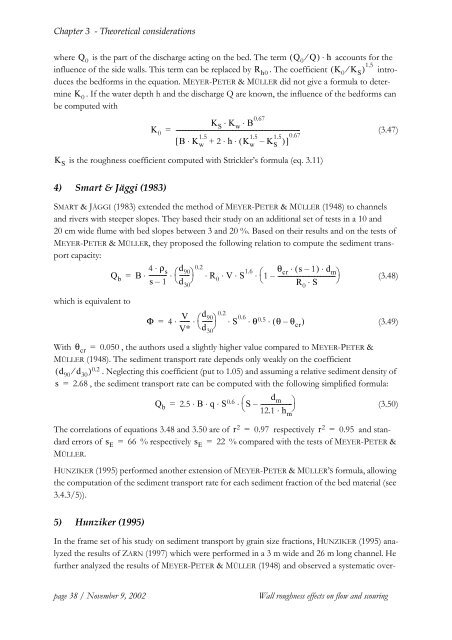pdf, 12 MiB - Infoscience - EPFL
pdf, 12 MiB - Infoscience - EPFL
pdf, 12 MiB - Infoscience - EPFL
You also want an ePaper? Increase the reach of your titles
YUMPU automatically turns print PDFs into web optimized ePapers that Google loves.
Chapter 3 - Theoretical considerations<br />
where Q 0<br />
is the part of the discharge acting on the bed. The term ( Q 0<br />
⁄ Q) ⋅ h accounts for the<br />
influence of the side walls. This term can be replaced by R h0 . The coefficient ( K 0<br />
⁄ K S<br />
) 1.5 introduces<br />
the bedforms in the equation. MEYER-PETER & MÜLLER did not give a formula to determine<br />
K 0 . If the water depth h and the discharge Q are known, the influence of the bedforms can<br />
be computed with<br />
K<br />
K S<br />
⋅ K w<br />
⋅ B 0.67<br />
0<br />
= ---------------------------------------------------------------------------------<br />
(3.47)<br />
1.5<br />
1.5 1.5<br />
[ B ⋅ K w<br />
+ 2 ⋅h ⋅( K w<br />
– K S<br />
)] 0.67<br />
is the roughness coefficient computed with Strickler’s formula (eq. 3.11)<br />
K S<br />
4) Smart & Jäggi (1983)<br />
SMART & JÄGGI (1983) extended the method of MEYER-PETER & MÜLLER (1948) to channels<br />
and rivers with steeper slopes. They based their study on an additional set of tests in a 10 and<br />
20 cm wide flume with bed slopes between 3 and 20 %. Based on their results and on the tests of<br />
MEYER-PETER & MÜLLER, they proposed the following relation to compute the sediment transport<br />
capacity:<br />
Q b<br />
B 4 ⋅ ρ s<br />
----------- ⎛<br />
d<br />
------ 90 ⎞ 0.2 (3.48)<br />
s – 1 ⎝ ⎠<br />
R 0<br />
V S 1.6 θ<br />
1 cr<br />
⋅ ( s – 1) ⋅ d<br />
= ⋅ ⋅ ⋅ ⋅ ⋅ ⋅ ⎛ – -------------------------------------- m ⎞<br />
⎝ ⋅ S ⎠<br />
d 30<br />
R 0<br />
which is equivalent to<br />
d 90<br />
V<br />
Φ = 4 ⋅ ------ ⋅ ⎛------⎞ 0.2 ⋅ S 0.6 ⋅ θ<br />
V∗ ⎝ ⎠<br />
0.5 ⋅ ( θ–<br />
θ cr<br />
)<br />
d 30<br />
(3.49)<br />
With θ cr<br />
= 0.050 , the authors used a slightly higher value compared to MEYER-PETER &<br />
MÜLLER (1948). The sediment transport rate depends only weakly on the coefficient<br />
( d 90<br />
⁄ d 30<br />
) 0.2 . Neglecting this coefficient (put to 1.05) and assuming a relative sediment density of<br />
s = 2.68 , the sediment transport rate can be computed with the following simplified formula:<br />
Q b<br />
2.5 B q S 0.6 d<br />
= ⋅ ⋅ ⋅ ⋅⎛S<br />
– -------------------- m ⎞<br />
(3.50)<br />
⎝ <strong>12</strong>.1 ⋅ h ⎠ m<br />
The correlations of equations 3.48 and 3.50 are of r 2 = 0.97 respectively r 2 = 0.95 and standard<br />
errors of s E<br />
= 66 % respectively s E<br />
= 22 % compared with the tests of MEYER-PETER &<br />
MÜLLER.<br />
HUNZIKER (1995) performed another extension of MEYER-PETER & MÜLLER’S formula, allowing<br />
the computation of the sediment transport rate for each sediment fraction of the bed material (see<br />
3.4.3/5)).<br />
5) Hunziker (1995)<br />
In the frame set of his study on sediment transport by grain size fractions, HUNZIKER (1995) analyzed<br />
the results of ZARN (1997) which were performed in a 3 m wide and 26 m long channel. He<br />
further analyzed the results of MEYER-PETER & MÜLLER (1948) and observed a systematic over-<br />
page 38 / November 9, 2002<br />
Wall roughness effects on flow and scouring
















